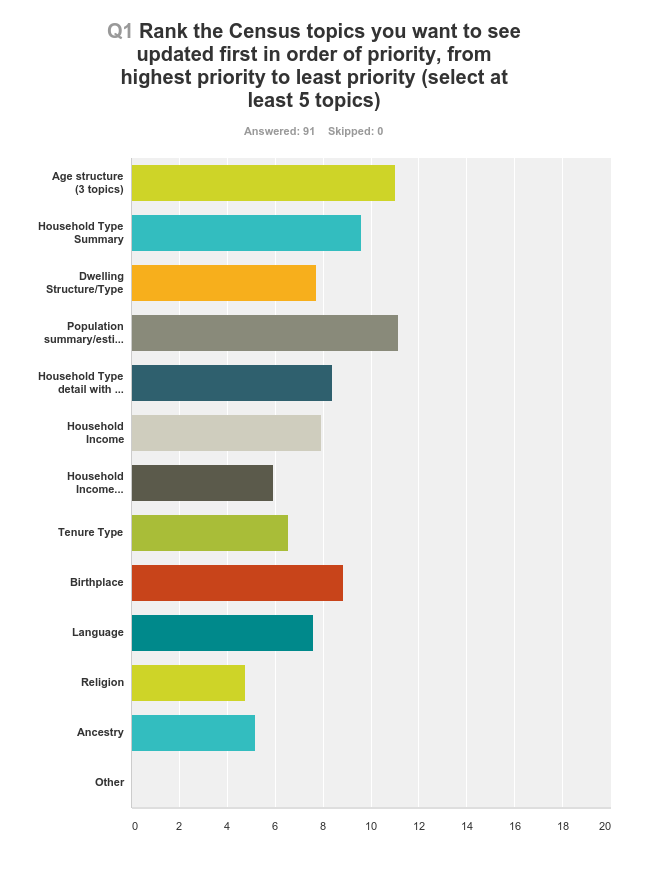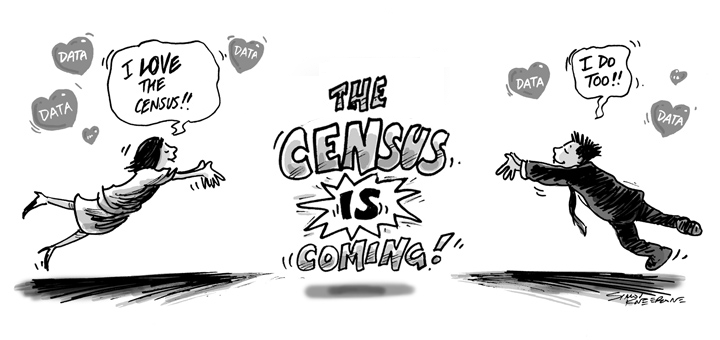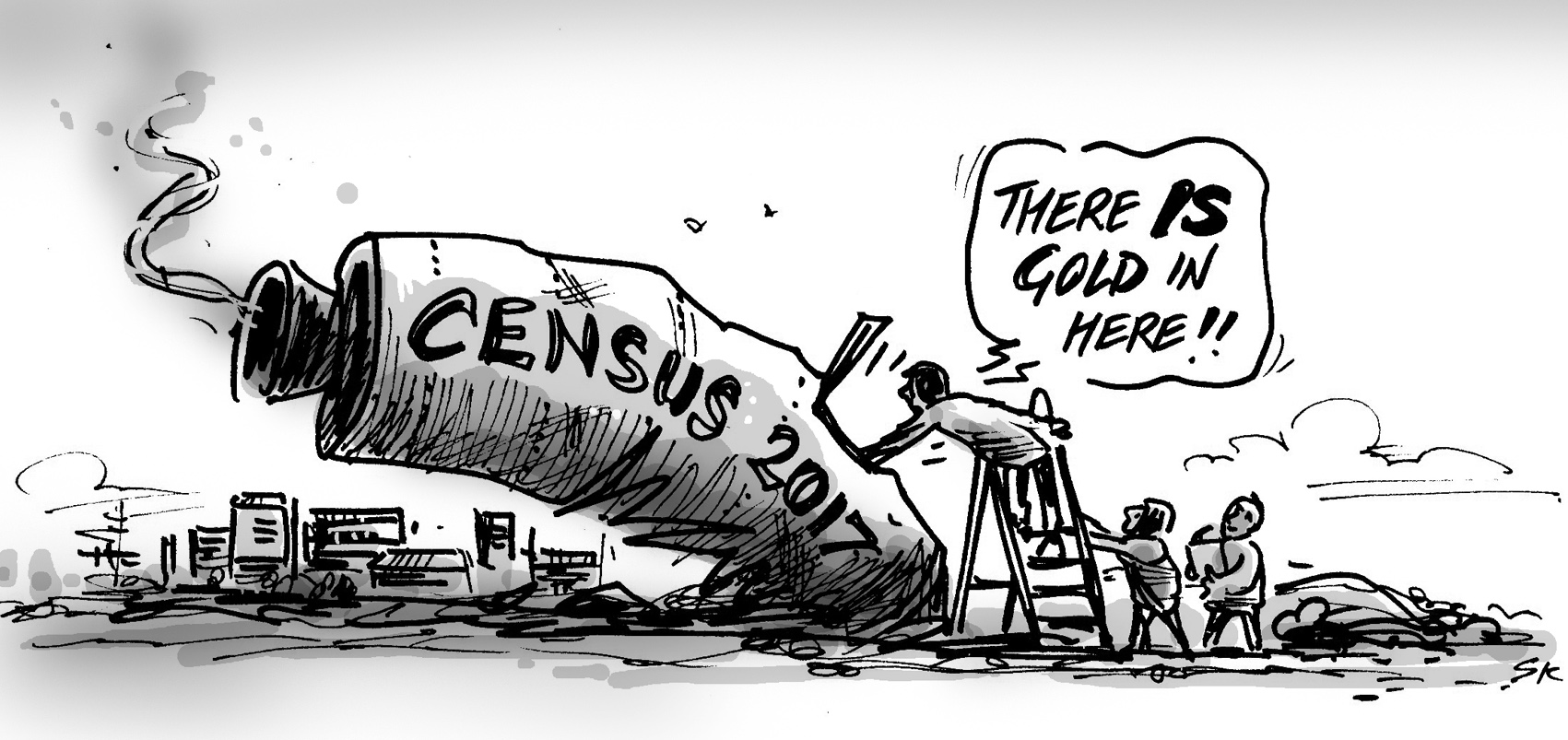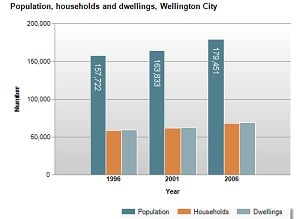As we make our final preparations to receive the 2016 Australian Census data from the ABS, we were interested to hear from our community as to which Census topics you would like us to update first at a small area level in our community profiles.
You may recall, we sent out some communications last month asking our users to vote on the topics they would like to see first in our Census updates.
When the ABS release the bulk of Census information later this month, .id will receive data for 12 topics. We plan to release the information at the Local Government Area (LGA) level for our community profiles first, to give people access to high-level information as quickly as possible.
Given there is some work involved in getting the data ready to use for the smaller geographic areas in our community profiles, we asked you to prioritise which topics you want us to roll out first at the local level.
So which Census topics are people most interested in?
The results are in from our poll, so we thought we’d share them with everyone. If you missed voting in the survey, we’d still love to hear your preferences – you can rank the topics here.
So far, 91 users have voted to rank the Census topics. The results, weighted by ranking are below.

The most popular Census topics
And the winner is…
Population summary/estimates
Equal with age structure in total ranking, but the population summary had the largest number of 1st place rankings, with about 50% of respondents putting it first. Probably no surprises here – ‘Population‘ is the most fundamental demographic question there is.
Now we have this result, we will be prioritising the Usual Residence and Enumerated population for immediate release. The interesting bit about this one, however, is that our population summary page is actually an aggregate of key statistics from a whole lot of different pages (eg. Males/Females, Australian Citizens, People over 15, Indigenous), so it’s quite complex to update. Estimated Resident Population is released a month after the main Census release, on 28th July, so can’t be updated until after that. Also, there are a couple of things we include in this page, like Employed Population which can’t be updated until 2nd release of data in October. So, we will update this section as much as possible from the initial data as a priority.
Age structure
There is probably no demographic characteristic more important than Age Structure. So it’s great to see that this one ranked equal first overall, with respondents consistently ranking it either first or second in most cases. In fact, Age Structure is so important that we actually have three different pages displaying the same data in different ways:
- Service age groups – age groups that consume similar council services, or are at a similar life stage.
- 5-year age groups – equal in size and allow direct comparison between age groups and show the ‘shape’ of the age distribution well.
- Single year of age – which gives fine detail and is presented as an age-sex pyramid also showing the shape of the population in more detail, but only for the latest year.
Age is also strongly related to most other Census topics. For instance, the type of household people form is strongly correlated to their age, as is the types of dwellings they live in, education and workforce participation.
Age is the bedrock of Census data, and will certainly be prioritised as one of the first topics we make available for small areas. Given the importance of this information, we have some future plans to help users visualise age structure even better using new features in profile.id (stay tuned).
Household type summary
Household structures are strongly related to age, but also tell you a lot about your area.
Does your area mainly house families with young children? Or are they mainly older with teenagers? Whether it’s ageing in place, with the kids leaving home, empty nesters and retirees, older lone persons, or young singles attending university, this topic gets to the fundamental nature of a place, so we will prioritise this information after age structure in our releases.
Birthplace
It was a little surprising to see this ranked so highly. A few respondents ranked it as #1, and almost half put it at #4 or above. There is obviously a lot of interest in our multicultural community, but this is one topic that is relevant to some areas more than others. It is also a topic that can change rapidly, and in less predictable ways, depending on where in the world people are migrating from in a particular year. Based on your feedback, we are likely to be moving multicultural topics up the priority list a little in our release schedule.
It is interesting that Birthplace ranked ahead of Language, Ancestry and Religion on average among our respondents. These 4 topics are often seen as a group, describing different aspects of multicultural population, but there is a clear preference for Birthplace among our respondents.
Birthplace is the most well defined and objective of these 4 topics. Most people know which country they are born in. In terms of providing council services, Language (and Proficiency in English) is likely to be the most useful, as Local Governments need to know which languages to produce and translate information in.
Birthplace only looks at first generation migrants. For instance, in the City of Fairfield in New South Wales, 52% of the population are born overseas, but 70% speak a language other than English at home.
Least popular Census topics
The wooden spoon goes to…
Religion
Religion was the least prioritised topic on the list. In a way this is not surprising – I’ve yet to see Religion used in a solid planning capacity among our Local Government clients. Religion is an optional question on the Census, and in modern Australia is mainly seen as a personal preference rather than a fundamental characteristic of individuals. There are no other questions on the Census which relate to opinions or ideologies.
Nevertheless, in terms of social commentary, it generates a lot of discussion when the Census is in the field and is sure to be a popular conversation starter when the data are out.
There is also a lot of misinformation about the religion results, such as people who claim you need to mark the “Christian” box to avoid a Mosque being built (there isn’t a “Christian” box, Islam made up a massive 2.2% of Australia last Census, and no-one uses the Census data for planning religious buildings anyway).
The 2016 Australian Census did make a significant change to the religion question, however, by moving “No Religion” as the first category in the list. This is likely to result in an increase in this category, so rather than seeing a Muslim takeover, it’s more likely we’ll see of Atheists and Agnostics becoming the largest group (see my Crystal Ball gazing for more predictions).
The rollout plan
The first release of 2016 Census data is happening on 27 June 2017. The 12 topics in the survey results above are the ones we will be receiving from the ABS on the day, so will be the first topics we can roll out; initially at the Local Government Level for all 12 topics, then in priority order over the following weeks for small suburban areas.
There are approximately 15 more topics in profile.id that will be available from the ABS 1st data release, which we will be working on adding to our sites over this timeframe as well.
While these topics are not as widely used, some of them will be very important to some people, so if you have any input on the priority for these remaining topics, please feel free to add your comments below. These topics include:
- Year of Arrival of overseas-born
- Proficiency in English of non-English speakers
- Highest level of schooling completed
- Educational institution attending
- Need for assistance with a disability
- Unpaid work (volunteering, domestic work and child care)
- Individual income
- Household size
- Rental payments
- Mortgage payments
- Number of bedrooms
- Internet connection
- Number of motor vehicles
Following the main release from the ABS, further topics will become available in the following release of Census data on 17 October 2017. These topics are:
- Employment status
- Industry
- Occupation
- Method of travel to work
- Level of qualification
- Migration within Australia (Migration by location)
- Journey to Work (worker origin and destination
With the 2016 Census data about to arrive, it’s a busy and exciting time at .id. If you’re eagerly awaiting the latest data to tell a story about your community, we’d love to hear about it! Leave a comment below, or tell us about it on our Facebook page.
.id is a team of population experts who combine online tools and consulting services to help local governments and organisations decide where and when to locate their facilities and services, to meet the needs of changing populations. Access our free demographic resources and tools here.










